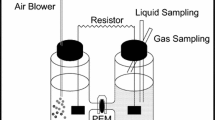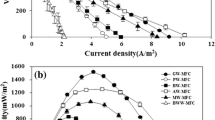Abstract
Biodegradations of Na-lactate and Na-acetate were evaluated in microbial fuel cell (MFC) type bioreactors. Increase in lactate concentration from 1,000 to 5,000 mg L−1 enhanced the biodegradation rate from 4.6 to 23.9 mg L−1 h−1. Sequential batch operation of MFC enhanced the lactate biodegradation rate. With acetate, neither increase in concentration nor sequential operation had a marked effect. Maximum power and current densities in MFCs operated batch-wise with lactate and acetate were 3.30 and 2.28 mW m−2, and 48.2 and 40.2 mA m−2, respectively. In the MFC operated continuously, increase in lactate loading rate caused the biodegradation rate to pass through maximum value of 1,668.2 mg L−1 h−1 (residence time: 1.2 h). Open circuit potential, power and current densities for continuous operation were 700 mV, 8.10 mW m−2 and 43.0 mA m−2, respectively. Using the experimental data, kinetic models for microbial growth and biodegradation of lactate and acetate in the MFC were developed.






Similar content being viewed by others
Abbreviations
- X :
-
Biomass concentration (mg L−1)
- t :
-
Time (h)
- µ max–Lac :
-
Maximum specific growth rate, lactate degradation (h−1)
- µ max–Ace :
-
Maximum specific growth rate, acetate degradation (h−1)
- S Lac :
-
Lactate ion concentration (mg L−1)
- S Ace :
-
Acetate ion concentration (mg L−1)
- K s–Lac :
-
Saturation constant for lactate degradation (mg Lac L−1)
- K s–Ace :
-
Saturation constant for acetate degradation (mg Ace L−1)
- K d–Lac :
-
Endogenous decay coefficient for lactate degradation (h−1)
- K d–Ace :
-
Endogenous decay coefficient for acetate degradation (h−1)
- Y x–Lac :
-
Yield constant for lactate degradation [mg cell-dry weight (mg Lac)−1]
- Y x–Ace :
-
Yield constant for acetate degradation [mg cell-dry weight (mg Ace)−1]
- R :
-
Ratio of residual to initial lactate concentrations
- F :
-
Proportion of reactions involved in lactate degradation (complete vs. incomplete oxidations)
References
Angenent LT, Karim K, AL-Dahhan MH, Wrenn BA, Dominguez-Espinosa R (2004) Production of bioenergy and biochemicals from industrial and agricultural wastewater. Trend Biotechnol 22:477–485
Du Z, Li H, Gu T (2007) A state of the art review on microbial fuel cells: a promising technology for wastewater treatment and bioenergy. Biotechnol Adv 25:464–482
Pant D, Van Bogaert G, Diels L, Vanbroekhoven K (2010) A review of the substrates used in microbial fuel cells (MFCs) for sustainable energy production. Bioresour Technol 101:1533–1543
Rabaey K, Van de Sompel K, Maignien L, Boon N, Aelterman P, Clauwaert P, De Schamphelaire L, Pham TH, Vermuelen J, Verhaege M, Lens P, Verstraete W (2006) Microbial fuel cells for sulfide removal. Environ Sci Technol 40:5218–5224
Park DH, Zeikus JG (2000) Electricity generation in microbial fuel cells using neutral red as an electronophore. Appl Environ Microbiol 66:1292–1297
Puig S, Serra M, Coma M, Cabre M, Balaguer MD, Colprim J (2010) Effect of pH on nutrient dynamics and electricity production using microbial fuel cells. Bioresour Technol 101:9594–9599
Lovley DR, Philips EJ, Lonergan DJ (1989) Hydrogen and formate oxidation coupled to dissimilatory reduction of iron or manganese by Alteromonas putrefaciens. App Environ Microbiol 55:700–706
Call DF, Logan BE (2011) Lactate oxidation coupled to iron or electrode reduction by Geobacter sulfurreducens PCA. Appl Environ Microbiol 77:8791–8794
Feng C, Li F, Sun K, Liu Y, Liu L, Yue X, Tong H (2011) Understanding the role of Fe(III)/Fe(II) couple in mediating reductive transformation of 2-nitrophenol in microbial fuel cells. Bioresour Technol 102:1131–1136
Rhoads A, Beyenal H, Lewandowski Z (2005) Microbial fuel cell using anaerobic respiration as an anodic reaction and biomineralized manganese as a cathodic reactant. Environ Sci Technol 39:4666–4671
Kim HJ, Park HS, Hyun MS, Chang IS, Kim M, Kim BH (2002) A mediator-less microbial fuel cell using a metal reducing bacterium, Shewanella putrefaciens. Enzym Microb Technol 30:145–152
Bretschger O, Cheung ACM, Mansfeld F, Nealson KH (2009) Comparative microbial fuel cell evaluations of Shewanella spp. Electroanalysis 22:883–894
Manohar AK, Mansfeld F (2009) The internal resistance of a microbial fuel cell and its dependence on cell design and operating conditions. Electrochim Acta 54:1664–1670
Min B, Cheng S, Logan BE (2004) Electricity generation using membrane and salt bridge microbial fuel cells. Water Res 39:1675–1686
Dr Bond, Lovley DR (2003) Electricity production by Geobacter sulfurreducens attached to electrodes. Appl Environ Microbiol 69:1548–1555
Liu H, Cheng S, Logan BE (2005) Production of electricity from acetate or butyrate using a single-chamber microbial fuel cell. Environ Sci Technol 39:658–662
Gregory KB, Bond DR, Lovley DR (2004) Graphite electrodes as electron donors for anaerobic respiration. Environ Microbiol 6:596–604
He Z, Angenent LT (2006) Application of bacterial biocathodes in microbial fuel cells. Electroanalysis 18:2009–2015
Clauwaert P, Rabaey K, Aelterman P, De Schamphelaire L, Pham TH, Boeckx P, Boon N, Verstraete W (2007) Biological denitrification in microbial fuel cells. Environ Sci Technol 41:3354–3360
Virdis B, Rabaey K, Rozendal RA, Yuan Z, Keller J (2010) Simultaneous nitrification, denitrification and carbon removal in microbial fuel cells. Water Res 44:2970–2980
Puig S, Coma M, Desloover J, Boon N, Colprim J, Balaguer MD (2012) Autotrophic denitrification in microbial fuel cells treating low ionic strength waters. Environ Sci Technol 46:2309–2315
Su W, Zhang L, Tao Y, Zhan G, Li D, Li D (2012) Sulfate reduction with electrons directly derived from electrodes in bioelectrochemical systems. Electrochem Commun 22:37–40
Coma M, Puig S, Pous N, Balaguer MD, Colprim J (2012) Biocatalysed sulphate removal in a BES cathode. Bioresour Technol 130:218–223
Sevda S, Dominguez-Benetton X, Vanbroekhoven K, De Wever H, Sreekrishnan TR, Pant D (2013) High strength wastewater treatment accompanied by power generation using air cathode microbial fuel cell. Appl Energy 105:194–206
Malaeb L, Katuri KP, Logan BE, Maab H, Nunes SP, Saikaly PE (2013) A hybrid microbial fuel cell membrane bioreactor with conductive ultrafiltration membrane biocathode for wastewater treatment. Environ Sci Technol 47:11821–11828
Zhang F, Ge Z, Grimaud J, Hurst J, He Z (2013) Long-term performance of liter-scale microbial fuel cells treating primary effluent installed in a municipal wastewater treatment facility. Environ Sci Technol 47:4941–4948
Li X, Zhu N, Wang Y, Li P, Wu P, Wu J (2013) Animal carcass wastewater treatment and bioelectricity generation in up-flow tubular microbial fuel cells: effects of HRT and non-precious metallic catalyst. Bioresour Technol 128:454–460
Karra U, Troop E, Curtis M, Scheible K, Tenaglier C, Patel N, Li B (2013) Performance of plug flow microbial fuel cell (PC-MFC) and complete mixing microbial fuel cell (CM-MFC) for wastewater treatment and power generation. Int J Hydrogen Energy 38:5383–5388
ElMekawy A, Diels L, De Wever H, Pant D (2013) Valorization of cereal based biorefinery byproducts: reality and expectations. Environ Sci Technol 47:9014–9027
Logan BE (2008) Microbial fuel cells. Wiley, New York
Marcus AK, Torres CI, Rittmann BE (2007) Conduction-based modeling of the biofilm anode of a microbial fuel cell. Biotechnol Bioeng 98:1171–1182
Hamelers HVM, Heijne AT, Stein N, Rozendal RA, Buisman CJN (2011) Butler–Volmer–Monod model for describing bio-anode polarization curves. Bioresour Technol 102:381–387
Picioreanu C, Head IM, Katuri K, van Loosdrecht MCM, Scott K (2007) A computational model for biofilm-based microbial fuel cells. Water Res 41:2921–2940
An S, Stone H, Nemati M (2011) Biological removal of nitrate by an oil reservoir culture capable of autotrophic and heterotrophic activities: kinetic evaluation and modeling of heterotrophic process. J Hazard Mater 190:686–693
An S, Loden B, Nemati M (2012) Evaluation of heterotrophic nitrite removal by a sulphide and acetate oxidizing mixed culture originated from an oil reservoir. J Chem Technol Biotechnol 87:410–417
You SJ, Zhao QL, Jiang JQ, Zhang JN, Zhao SQ (2006) Sustainable approach for leachate treatment: electricity generation in microbial fuel cell. J Environ Sci Health A 41:2721–2734
Rabus R, Hansen TA, Widdel F (2006) Dissimilatory sulfate- and sulfur-reducing. In: Dworkin M, Falkow S, Rosenberg E, Schleifer KH, Stackebrandt E (eds) The prokaryotes, 3rd edn. Springer, New York
Reardon KF, Mosteller DC, Bull-Rogers JD (2000) Biodegradation kinetics of benzene, toluene and phenol as single and mixed substrates for Pseudomonas putida F1. Biotechnol Bioeng 69:387–400
Abuhamed T, Bayraktar E, Mehmetoglu T, Mehmetoglu U (2003) Kinetics model for growth of Pseudomonas putida F1 during benzene, toluene and phenol biodegradation. Process Biochem 39:983–988
Juang RS, Tsai SY (2006) Growth kinetics of Pseudomonas putida in the biodegradation of single and mixed phenol and sodium salicylate. Biochem Eng J 31:133–140
Koike I, Hattori A (1975) Energy yield of denitrification: an estimate from growth yield in continuous cultures of Pseudomonas denitrificans under nitrate-, nitrite- and nitrous oxide-limited conditions. J Gen Microbiol 88:11–19
Kornaros M, Lyberatos G (1998) Kinetic modelling of Pseudomonas denitrificans growth and denitrification under aerobic, anoxic and transient operating conditions. Water Res 32:1912–1922
Pant D, Arslan D, Van Bogaert G, Gallego YA, De Wever H, Diels L, Vanbroekhoven K (2013) Integrated conversion of food waste diluted with sewage into volatile fatty acids through fermentation and electricity through a fuel cell. Environ Technol 34:1935–1945
El Mekawy A, Srikanth S, Vanbroekhoven K, De Wever H, Pant D (2014) Bioelectro-catalytic valorization of dark fermentation effluents by acetate oxidizing bacteria in bioelectrochemical system (BES). J Power Sources 262:183–191
Acknowledgments
This work was made possible by the financial support of the Saskatchewan Ministry of Agriculture (Agriculture Development Fund) and a Discovery Grant provided to MN by the Natural Sciences and Engineering Research Council of Canada (NSERC).
Author information
Authors and Affiliations
Corresponding author
Rights and permissions
About this article
Cite this article
Moreno, L., Nemati, M. & Predicala, B. Biokinetic evaluation of fatty acids degradation in microbial fuel cell type bioreactors. Bioprocess Biosyst Eng 38, 25–38 (2015). https://doi.org/10.1007/s00449-014-1240-3
Received:
Accepted:
Published:
Issue Date:
DOI: https://doi.org/10.1007/s00449-014-1240-3




